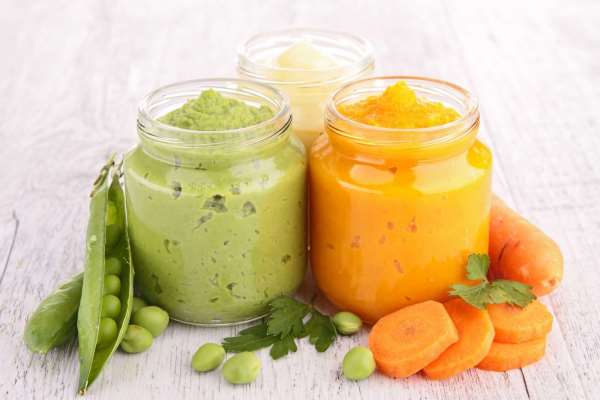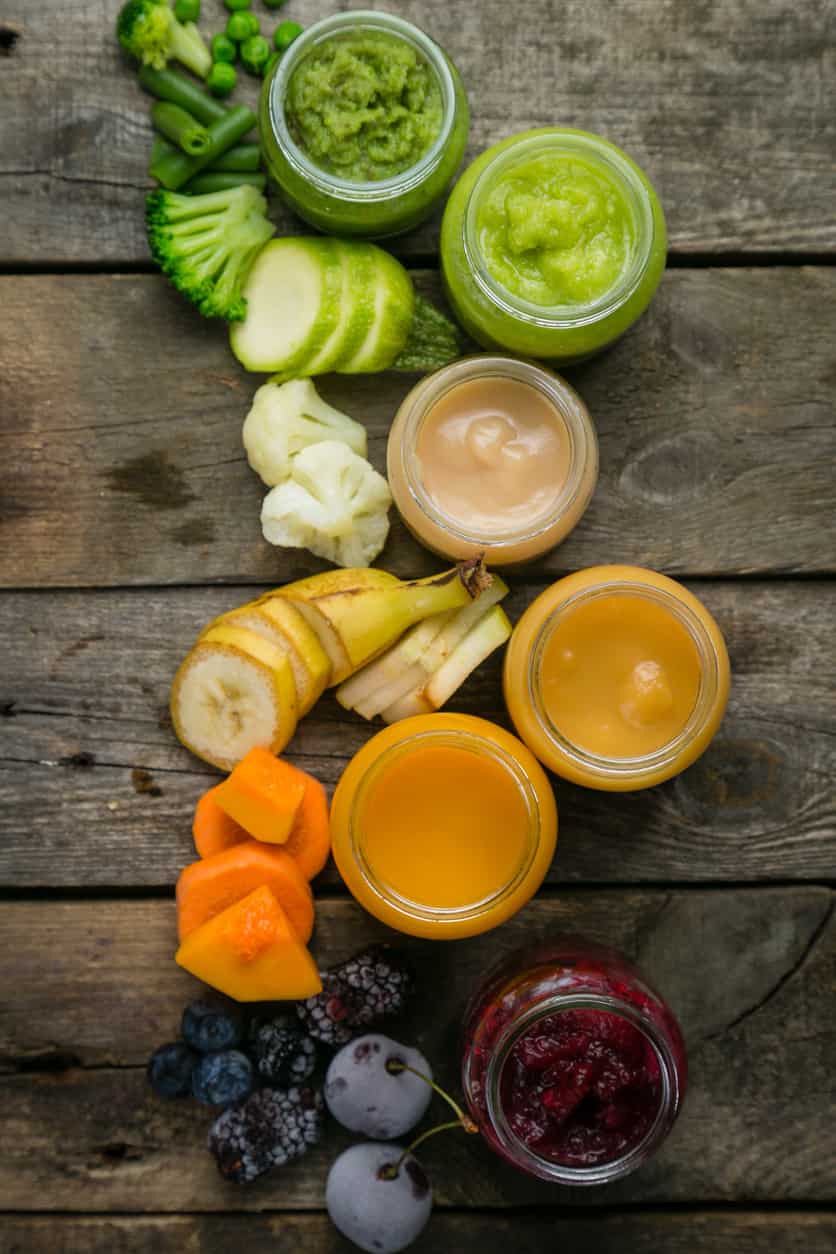Key Points
- Baby food is easy to make and can save you a noticeable amount on groceries every month.
- You'll want to consider investing in a baby food grinder or all-in-one baby food maker.
- Make sure you consult your pediatrician with any nutritional questions or concerns.
When children turn the age where they can start eating baby food (around 6 months), many parents decide to go to the store to buy what they need. However, when a baby eats multiple times per day, you may soon find that half of your grocery budget goes to buying their food. As an alternative, you can make baby food at home with natural ingredients that you may already have in your pantry.
Today, we will tell you about the benefits of making food at home and many recipes that you can start preparing today.
Why You Should Make Baby Food at Home

©iStock.com/margouillatphotos
If you are on the fence about making your own baby food, then we have some reasons why you might consider the idea.
For starters, you can save money. According to Investopedia, you can expect to spend around $100 on baby food every month. That may not necessarily break the bank, but it is more than you would spend on the fruits, vegetables, and meat that you pay for when you make the food on your own. Plus, other people in the family can eat those same ingredients as well.
Baby food is also easy to make. Once you have the proper tools, you can make several portions of a variety of flavors in a matter of minutes or less. After a few days of practice, it will be like second nature. In addition to being easy, you will also have great pride knowing that you made the healthy food that your child needs with your own hands. The act makes parenthood feel very rewarding.
The Steps To Making Homemade Baby Food
The skills necessary to make baby food at home are very simple. Mostly, it is about having the right tools and knowing how to use them. Note that the process basically involves grinding up food, so you can use any of the following tools:
- A baby food grinder (The simplest way to go. It is an all-in-one device)
- A hand-turned food mill (Can be used for baby food and other applications)
- An all-in-one baby food maker (It steam-cooks and purées the food)
You will also need various kitchen tools that you probably use on a daily basis, which include:
- Strainer or sieve
- Pot or pan
- Peeler
- Fork (it is the easier way to mash foods, like avocados and bananas)
Once you have everything you need, you can start the process of making the baby food.
1. Clean Your Workstation
The first step is to wash your hands and sanitize the area, especially if you will be working with meat, eggs, and raw fish. If you do touch those items, then wash your hands again afterward. Also, clean all utensils before use.
2. Prepare the Food
Before you put the food in the grinder, you will want to prepare everything. The prep work you do will depend on the items you are cooking:
- Remove all seeds and pits from applicable foods.
- Wash vegetables before preparing to eliminate any dirt or pesticides.
- When cooking any food, cook it until it is tender.
- Retain the vitamins and minerals in fruits and vegetables by steaming them in a little water.
- When cooking meat and fish, remove all skin, gristle, and bones.
- Puree fresh fruit in its own juice.
- Avoid foods that can be a choking risk for infants, including grapes, raisins, and pieces of hot dog.
- Cool all eggs, poultry, and meat until well done to avoid the risk of food poisoning.
- If you are also cooking for the family, then separate the baby’s portion before you add salt and seasonings. Seasonings won’t necessarily hurt the baby but they may still be sensitive to them.
3. Chop Up the Food
Once you have properly prepared your ingredients, chop them into half-inch-sized cubes.
4. Boil the Food
Put the food in a pot. Make sure there is just enough water in there to almost cover them. Cover the pot with a proper lid and bring it to a boil. At that point, lower the heat and let the food simmer until it becomes tender.
5. Transfer to the Blender
Once the ingredients are tender enough, transfer them over to the blender. Work the machine until the food is in a fine paste or it is at the proper consistency for your baby to eat.
Storing the Baby Food You Have Left Over
Many parents choose to make baby food in medium to large servings so they can have enough to last and they don’t need to make it fresh for every meal.
If you do, then you must refrigerate or freeze it right away. Do not leave baby food out at room temperature for more than two hours.
In general, you can keep food that is made of seafood, poultry, eggs, and meat in the refrigerator for 24 hours. You can keep food made from fruit and vegetables in the fridge for 48 hours. However, both can stay good in the freezer for up to a month.
Wherever you store the food, make sure that it is in airtight containers or sanitized mason jars. Typically, you can store 1-2 teaspoons of a particular food. Make it small so that it is easy to mix, defrost, and serve without making a mess.
When it comes time to reheat the food, you can do so in the microwave or a pan on the stove.
Ingredients to Consider When Making Baby Food
Now that you know how to make the actual baby food, you may be wondering which ingredients you should include. It really depends on your baby. However, there are many foods that you might consider for their vitamins, nutrients, and general healthy properties:
Bananas – They are soft and easy to eat and prepare. They are also full of vitamins and potassium.
Avocados – Also soft and easy to mash, avocados give your baby a great texture to start with and they contain healthy fats.
Berries – A must-have that are full of vitamins and antioxidants.
Green vegetables – Green beans, broccoli, and other vegetables are packed with vitamins and you can blend or steam them.
Beans – Just about any type of bean will be good for your baby as they are packed with protein, vitamins, and minerals, like iron and zinc.
Meat – Turkey, fish, beef, and chicken are all okay for babies and they are all packed with protein.
Sweet potatoes – They are packed with vitamin C. When preparing, cook to soften them and then blend or mash it.
Squash – Tastes good alone and when paired with other vegetables. Like sweet potatoes, cook and then blend or mash it.
Oats – They are loaded with fiber and iron and can be paired with many other tasty ingredients.
Quick Tips

©iStock.com/a_namenko
Here are some quick tips to remember when it comes to making baby food:
Allergenic Foods
Consider feeding your child commonly allergenic foods like eggs, diary, and peanut butter, early in their life. Doing so can prevent your baby from getting these allergies in the future. If you are concerned, then speak to your pediatrician first.
Store-Bought Food is Healthy Too
If you would like to make food at home but you just don’t have the time, then don’t fret. The store-bought food will still have the nutrients that your baby needs to thrive.
Be Cautious With Fish
While the more common types of fish are very healthy for your baby, some types can be dangerous. Tilefish, marlin, and shark meat can contain high levels of mercury that can be harmful for your child, so try to avoid them.
Keep Your Pediatrician Updated
Make sure your pediatrician is kept in the know about any significant changes you want to make to your baby's diet. You'll want to get the all-clear from them before changing anything significant.
Variety is Key
You don't want to feed your baby the same two foods over and over again! Keep their diet varied to ensure they're getting the nutrients they need. In addition, variety will help prevent boredom and fussiness when it comes to their food.
Conclusion
As you can see, if you have the desire and the time, then it is worth it to make baby food at home. Consider the tips and advice discussed here and you can save money and have pride in the fact that you are providing tasty and healthy food to your baby girl or boy.
The image featured at the top of this post is ©iStock.com/monkeybusinessimages.
